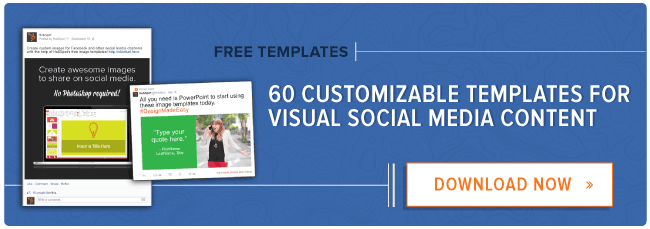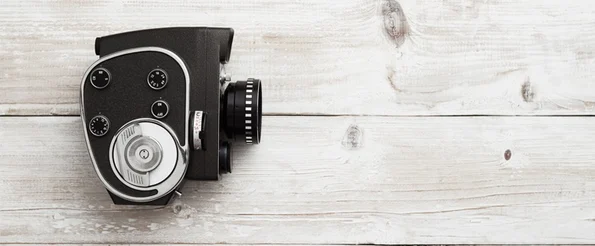As you may have picked up by now, visual content is a fantastic marketing weapon. People are naturally attracted to images more than text, it's highly shareable, and social networks are increasingly jumping on the visual content bandwagon.

In fact, social networks are cropping up solely to take advantage of this visual craze. (Pinterest, Instagram, and Vine, anyone?) Even social networks that didn't start out very visual are featuring visual content more prominently. Facebook is a great example of this -- we've already seen them make updates to make images much larger and more visible in the News Feed.
So what's a marketer to do? The first step is to invest in visual content creation (this crash course in do-it-yourself visual content design should help big time). But we're going to take it one step further and assume you're already doing that -- specifically focusing on visual content for your blog. Once you start incorporating more visuals into your blog, how can you increase that visual content's shareability? We're going to break out eight ways to do this so you can start increasing the reach of your visual blog content ASAP.
8 Ways to Make Your Visual Blog Content More Shareable
1) Make content easy to share with social sharing buttons.
The best way to increase the shareability of your visual blog content (or any text-based content, for that matter), is to make it easy for your blog visitors to share it. Social sharing buttons are like little calls-to-action that subtly say, "Hey, you liked this? Why not pass it along?" Add some social proof to these sharing buttons in the form of share counts, and you can add a little "See? Everybody's doing it ..." oomph. For instructions about how to create social sharing buttons for the top social networks, check out our ultimate cheat sheet for creating social media buttons.

2) Add Pin It buttons next to visual content within blog posts.
One of the buttons covered in that social media buttons cheat sheet is Pinterest's Pin It button, but it's also worth calling out separately. Pin It buttons make it easy for Pinterest users to share visual content to Pinterest. They're particularly beneficial for giving visual content such as infographics and other visualizations extra reach, since you can place these buttons within your blog content right next to the visual content you want people to share. For example, if we had created a visual to explain a difficult-to-understand concept (like closed-loop marketing), it'd be smart to add a Pin It button to it, like you see below:

Tip: Include your logo in infographics and visualizations like the one above. This way if it gets shared far and wide but people don't attribute you properly, the logo will always be there.)
3) Create a blog content pinboard.
Speaking of Pinterest, if you want to give your visual blog content a jumpstart, why not create a pinboard specifically dedicated to featuring your blog content? The great thing about this is, you don't even have to feature content that is particularly visual. Just make sure you include a compelling and interesting image within the post, and use that as the image you pin. Here's how we do it on HubSpot's pinboard for this very blog:
This leads me to number four ...
4) Put extra care into choosing high-quality images for your blog content.
The images you choose for your blog content matter, especially since most social networks automatically pull in images with the links people share. As a result, incorporating compelling, high-quality images into your blog content shouldn't be an oversight. A great image can catch people's attention and increase clickthroughs to your content, so spend some time on image selection and choose an image that's both relevant to your content and appealing. We're fond of Creative Commons. Just be careful about image attribution, and when in doubt, you can always purchase a stock photo here and there. In fact, we have 75 stock photos that are free to download -- no attribution required -- right here.
5) Use Facebook's photo sharing feature, not its status update option, to share links to your content.
Here's why ...

See how much more space the version on the right takes up? The version on the left was shared using the general status update option in the composer, whereas the version on the right was shared using the photo share option. Because Facebook features visual content much more prominently in Timelines and in the News Feed, upload an image and include a link to the content in the image's description for more bang for your buck.

6) Create custom images specifically to promote blog content in social.
Another thing you can do to optimize blog content that isn't particularly visual for better shareability is to create custom images that you can use specifically for social media promotion. The example below was created by our social media manager in PowerPoint to promote this post on HubSpot's Facebook Page, proving you don't need a ton of fancy, expensive software to leverage the power of visual content.
7) Turn text-based content into SlideShares.
SlideShare presentations can make for great visual blog content, and the SlideShare website also gets a lot of traffic. Try turning some of your successful text-based content into a visual SlideShare, and embed it as a post on your blog. At HubSpot, we've found that posts with embedded SlideShares generate an average of 34% more views and 29% more inbound links than the average non-SlideShare post on this very blog. For tips about how to create a SlideShare, check out this post. You can also see an example of one of our most successful SlideShare-focused posts here. (Tip: Accompany your SlideShare post with copy for SEO and for visitors who prefer text-based content over visual content.)
8) Create embed codes for your infographics.
Social networks aren't the only vehicles for extending the reach of your visual blog content. Getting other bloggers and publishers to share your visual content on their websites is a great way to reach new audiences and drive traffic back to your blog. Because they're easy for others to embed, SlideShares are one great type of visual content for this. Infographics are another great option. So to make it easy for others to publish your infographics on their own websites, you need to ... make it easy. But unlike SlideShares, infographics don't have embed codes built in. Luckily, with Siege Media's Embed Code Generator, they're painless to create. We've even whipped up a tutorial for you the next time you're trying to figure out how to create an embed code.
In what other ways can you increase the social shareability of your visual blog content? If you're looking to get started, feel free to grab those free stock photos we mentioned earlier right here.
Image Credit: Scinern





![How to Make an Animated GIF in Photoshop [Tutorial]](https://www.hubspot.com/hubfs/how-to-create-animated-gif_6.webp)

![How Visuals Will Impact Marketing in 2017, According to New Data [Infographic]](https://53.fs1.hubspotusercontent-na1.net/hubfs/53/00-Blog_Thinkstock_Images/how-visuals-impact-marketing-2017.png)
![How to Create an Attention-Grabbing Poster Design for Any Event [Infographic]](http://53.fs1.hubspotusercontent-na1.net/hubfs/53/event%20posters.png)
![How the Brain Processes Different Types of Content [Infographic]](http://53.fs1.hubspotusercontent-na1.net/hubfs/53/brains-process-content1-compressor.jpg)


![The ABCs of Compelling Visual Ads [Infographic]](http://53.fs1.hubspotusercontent-na1.net/hubfs/53/Visual_Ad_Design.jpg)
![How to Create Better Content Than Your Competitors [Infographic]](http://53.fs1.hubspotusercontent-na1.net/hubfs/53/00-Blog_Thinkstock_Images/how-to-optimize-content.jpg)